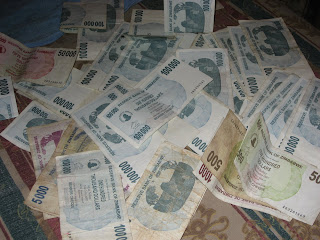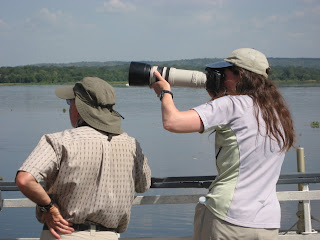On April 6, 1994, in a tiny country in the heart of East Africa, all Hell suddenly broke loose.
At 8:20PM, there was an explosion at the Kigali International Airport. A plane had crashed, killing all the passengers inside, including Rwandan president Juvenal Habyarimana. The aircraft had been shot down by a rocket.
Within an hour, a dark shadow befell the entire nation. Roadblocks were erected everywhere, manned by ordinary civilians armed with guns and machetes, who demanded to see ID cards from any passers-by. Meanwhile, just as people were settling into their beds for the night, a series of home invasions began to occur. Again, those responsible were plainclothes Rwandas with weapons.
Who were they? Members of the Interahamwe, an extremist militia whose named meant "Those Who Kill Together".
Their mission? To systematically exterminated every single Tutsi living in Rwanda.
During the month that followed, an estimated 800,000 Tutsis lost their lives. Many of them suffered unimaginably horrific deaths. The rest of the world, meanwhile, turned a blind eye.
The UN, who already had a small task force in Rwanda, proved its ineptitude beyond any reasonable doubt. Mission Commander Romeo Dallaire, who recognized what was happening, pleaded with his senior bureaucrats in New York for more troops to help curb the violence, but his cries fell on deaf ears and were only met with skepticism.
The Belgians, who lost 10 peacekeepers at the hands of the Interahamwe, pulled all their men out.
The French sent in a small army, though only to oversee the safe evacuation of all French nationals in the country.
The Americans, who were perhaps in the best position to help, spend the entire month arguing internally over whether or not "genocide" was a suitable term to apply to the atrocities. In the end, congress deemed that it was only "ethnic tension" and decided to do nothing. (Though to be fair, the Americans had just suffered a humiliating defeat in Somalia and weren't too keen on shipping men back to Africa).
So the Tutsis were left to die. And they probably all would have died, had it not been for the Rwandan Patriotic Front, a rebel army of previously-exiled Tutsis led by Paul Kagame, who captured Kigali in May of '94 and put an end to the slaughter.
...
It's now 13 years later, and I am in Rwanda. What shocks me the most about the place is that, from my perspective, things seem pretty normal. There are stray goats, busy markets, honking horns, women selling mangoes, men yelling at the TV while watching football, and children playing with old tires. Nothing amiss there. But that said, it isn't hard to realize that many of these people have been through Hell. And to understand their plight a bit more, I made a pilgrimage to the Genocide Memorial Centre in Kigali.
The GMC was set up by the government and is meant to show the world what they missed seeing the first time. Admission is free. The visit starts with a video documentary that highlights the genocide from beginning to end. There were many grisly images, though for me what was more difficult to stomach were the interviews with Clinton and Annan - people who could have done something, but didn't. Boy, is hindsight ever 20/20.
Next, you have a chance to learn about the history of Rwanda up until the time of the genocide. You discover that "Hutu" and "Tutsi" do not have racial denotations; before the Belgians arrived in 1923, Rwanda had 18 tribal clans, and Hutu and Tutsi were terms used to describe one's socio-economic status within their own clan. By introducing identity cards, the Belgians consolidated Rwanda into two clans, and thus racially divided the nation, with the Tutsis becoming the rich minority. The Catholic Church, which had an active role in the country at the time, fully supported this new system. The seeds of genocide were planted by foreigners.
Soon, you reach the exhibition detailing the genocide itself. It is horrific. The Tutsis were not just killed. They were beaten. They were mutilated. They were crucified on trees. They were thrown into pits and stoned. They were drowned in septic tanks.
Women were raped by Hutu men who knowingly had HIV.
Husbands were forced to kill their own wives.
Children were murdered so that the next generation of Rwandans would be 100% Hutu.
At the GMC, you get to see all of this. There are silent photos of kids with gangrenous wounds, recorded interviews with Tutsis who had watched their loved ones get killed, and piles of rusty machetes used in the massacre.
In one room there are clothes on display, worn by the victims on the day they died. One of the t-shirts said "Ottawa Senators" on the front, and had a blood-stained slash across the chest. That shirt would have fit me when I was 5.
In another room you see the faces of the actual victims: over 1000 photos of people who had been killed, their innocent eyes staring at you as you try to comprehend the potential magnitude of the evil inherent to humans.
Still feel like more?
If at this point you haven't got the message, then it's the last room that truly puts your heart in a vise.
In this last room are photos of children. Life-sized photos, taken from when the kids were happy and full of life, before they were stolen from this world by monsters. Each photo has an inscription with the child's name, as well as a few other pertinent details. An example:
Mami MPINGANZIMA
Age: 12
Enjoyed: Chips with mayo
Favourite Song: The Beauty of Women
Last Words: "Mom, where can I run to?"
Cause of Death: Shot dead
Sadly, this kid was probably lucky. Here are a few more.
Patrick Gashugi SHIMIRWA
Age: 5
Favourite Sport: Riding his bike
Best Friend: Alliane, his sister
Behaviour: A quiet, well-behaved boy
CoD: Hacked with machete
Ariane UMUTONI
Age: 4
Favourite Food: Cake
Enjoyed: Singing and dancing
Behaviour: A neat little girl
CoD: Stabbed in her eyes
Irene UMOTONI and Uwamwezi UMUTONI
Relationship: Sisters
Favourite Toy: A doll they shared
Behaviour: Daddy's little girls
CoD: Grenade thrown into their shower
Fillette UWASI
Age: 2
Favourite Food: Rice and chips
Best friend: Her Dad
CoD: Smashed against a wall
Aurore KIRIZI
Age: 2
Behaviour: Very talkative
Favourite Drink: Cow's milk
Favourite Game: Hide and go seek
CoD: Burnt alive
To conclude, I'll go back to what I said earlier: Rwanda, now, is pretty normal. To the average tourist, there is hardly any difference between here and Tanzania or Malawi. But beneath the surface, Rwandans still have the scars from what happened. There are still women here who have HIV from being raped. There are still children here whose parents were killed. There are still men here who did the killing, and will have to live with it forever.
As will all the people who saw what was happening and ignored it.
The world really sucks sometimes.















